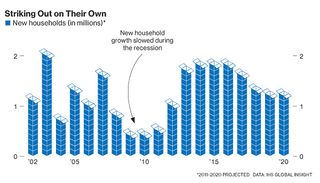Starting in 1960, the U.S. Census Bureau began tracking a statistic called Household Formations. If you're a real estate owner or manager who has the responsibility for replacing an aging workforce over the next five to ten years, it might be a metric you want to start noticing. 
In a recent article in Business Week, economists reported a little bump in consumer spending they attribute to the fact that more adult children are moving out of their parents homes and starting households on their own. This is not the only source of new household formations, but it traditionally accounts for the major trending in this statistic (divorce stats affect this metric as well). If kids are getting out of college and obtaining well-paying jobs, they strike out on their own and set up households.
In the last few years, the opposite has been true. Business Week reports:
"About 20 million adult children in the U.S. live with their parents, and most are eager to move, says Peter Francese, a demographic analyst for advertising agency Ogilvy & Mather. 'Most guys who live at home beyond some young age walk around with a great big 'L' [for "loser"] on their forehead,' Francese says. 'As more young people feel they will be able to keep a job, bingo, they're gone.'
Next year, nearly 1 million new households will be created, UBS Securities (UBS) predicts, up from the 357,000 in the year ending March 2010, the lowest number for a 12-month period on record since the Census Bureau started tracking household starts in 1960. U.S. household formation in the three years ending March 2010 was roughly 40 percent of the long-term average, or about 500,000 annually, according to Census data."
The article goes on to spout optimism about how this economic indicator is starting to fuel consumer spending; the average person spends $1,900 on consumer goods setting up their household. Will this change spur economic growth? I'm not sure–it may be best to just let the prognosticators debate that issue. I'm more interested in the 19 million adult children who are stuck living with their parents because they can't find a job. Let's take a closer look at this data.
As the graph to the left illustrates, the number of new households is quite low. The IHS Global Insight researchers have estimated this trend will dramatically change in the next couple years. Let's suppose this does happen (which I doubt it will). If nine million new households are formed over the next five years, this only reduces the backlog to 11 million adult children living with their parents.
My calculation above also assumes that there will be no new people graduating from college and moving back in with their parents. While it may be difficult to draw a line on where a college grad crosses from "underemployment" (they have a low paying job that does not match their degree) to "employment" (they have a job that pays enough for them to move out of their parents' house), I've tried to do my best to come up with an accurate number. Here are two (1, 2) of several articles I've read on this topic.
I think there will be about 700,000 new college grads entering into this unemployment/underemployment state each year, for the next few years. Taking into account those who do not have degrees who also will be finding themselves in this state, the number of new adult children who move back in with their parents will be much higher. By the way, the average person who is considered "underemployed" makes $400/week.
So, it's probably safe to say that the backlog of adult children who are living with their parents will not diminish quickly. It is quite likely that this number will remain significantly above 10 million people for some time.
Here's a question for you: Do you believe this large group of candidates could help solve the significant recruiting challenges that will face the real estate industry in the next five years?
You may comment confidentially by replying to workpuzzle@hiringcenter.net. If you want to share your response with others, use the comment link on localhost/Mahesh/wordpress/.
In my next post, I'll discuss reader comments and provide some comments of my own.
Editor's Note: This article was written by Ben Hess. Ben is the Founding Partner and Managing Director of Tidemark, Inc. and a regular contributor to WorkPuzzle. Comments or questions are welcome. If you're an email subscriber, reply to this WorkPuzzle email. If you read the blog directly from the web, you can click the "comments" link below.


